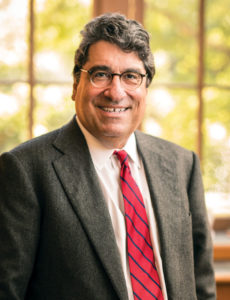
Coming in to work every day just steps away from a major construction project might seem like a headache for some people. Jackhammers drumming. Saws screeching. Bulldozers, cranes and other heavy equipment beeping their warnings at all hours.
But to me these sounds are echoes of our mission coming to life, proof that Vanderbilt is thinking big and following up with bold action. That’s what the late E. Bronson Ingram was known for, so it’s only fitting that our latest residential college, nearing its 2018 completion next door to my office in Kirkland Hall, is being named in his honor.
As my eye travels further along West End Avenue, I’m reminded of the transformational work to come. Starting in January we aim to break ground on a project to replace Carmichael Towers with three new breathtaking residential colleges, extending the parklike feel of the main campus to an area now dominated by asphalt and parking lots.
Why take on this ambitious endeavor? Why invest in building community, not just housing? Why now?
The answers to these questions are at the heart of our commitment to educating the whole student. Our students spend about 16 or 17 hours each week in the classroom. Learning doesn’t end after those classroom hours. In many ways, that’s when it begins. Especially now, when public dialogue is increasingly discordant, our imperative to teach and model reasoned, civil discourse from all viewpoints and perspectives is more urgent than ever.
Residential colleges make a Vanderbilt education a 24/7 experience. They provide an immersive environment where core values like civility, inclusion and empathy are not just taught, but are lived. This is why we are investing strategically in building living–learning environments that encourage our students to ask, with an open and inquisitive mind, the questions that will prepare them to lead: “Why do you think that?” “Can you tell me more?” “Can we solve this together?”
The community we are building today is in some ways a vast amplification of efforts that started nearly three decades ago when Vanderbilt signed on as the inaugural school to participate in the Posse Scholars program, which identifies talented students from low-income backgrounds and helps them pay to attend a top-tier university.
As you will read in this feature, Vanderbilt alumna and Board of Trust member Shirley M. Collado, BS’94, a member of the first Posse class in 1989, dared to board a bus from her Dominican neighborhood in New York City and travel to this unknown place called Vanderbilt. It was one of many firsts for Shirley, who this summer became president of Ithaca College, placing at the center of her leadership agenda an effort to foster dialogue and inclusion among the entire school community. The bright light of Shirley’s leadership shines across higher education, and as a member of our board, we continue to benefit from her vision and service at Vanderbilt.
Our newest students are building on the legacy of excellence established by Shirley and so many of our remarkable alumni. This year Vanderbilt welcomed the most academically accomplished and diverse class in the university’s history. More than 90 percent of the entering class were in the top 10 percent of their high school graduating classes, and fully 45 percent of the 1,607 freshmen come from minority groups. All of them are demonstrated leaders.
Critical to building a robust academic institution, of course, is having the ability to attract a world-class faculty. That is why Vanderbilt announced this fall that it is investing $30 million in the Chancellor’s Chair Challenge. We hope to add 30 endowed chairs—the highest academic honor we can bestow on a faculty member—to our 420 current endowed chairs. These chair designations signify an enduring commitment to advance groundbreaking research and discovery, some of which you will read about in this issue’s cover story, spanning areas from the humanities to the latest scientific and engineering breakthroughs.
As many of you saw at Reunion in October, and as you will read about in this issue, a lot of building is happening on campus—in ways visible and not. But it’s not just a single building or university initiative. Together we are building the future of this great university.
—NICHOLAS S. ZEPPOS, CHANCELLOR